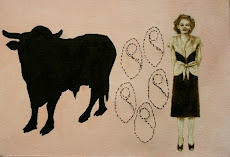WITH
ARTIST NEAH BAHJI KELLY

GESTURE 7

AFTER GESTURE 7
WHEN DID YOU START TO PAINT?
I first started to paint towards the end of my first year in college. I had a required painting class in the second semester of that year and that was when I started to develop a greater interest in painting. Before that I wasn’t too interested. My dad is a painter and I think because of that, I just never wanted to try it, it didn’t seem mysterious enough.
I think I am pretty influenced by minimalism and colour field painting. I also think that because of the way I work with paint, which is in a lot of layers with very thinned down paint, I have a strong relationship with people like Helen Frakenthaler and Morris Louis. I have definitely looked at these painters a lot.
WHAT IS THIS SERIES ABOUT?
This series is based on an article I read; at least this is where the idea began. I read an article by Zacharias Kunuk in which he talked about his filmmaking process. He talked about authenticity and something he termed “the significant gesture”. To Kunuk the significant gesture referred to the moment he captured on film of his actors portraying their parts in a very authentic way. Kunuk, in a lot of his films would have his actors improvise their parts which might give a better idea of the authenticity he was after. I heard this phrase and it captured my imagination. I wondered what it would look like in visual terms. Right away I saw it and felt it as something immediate, a gesture, a reaction, something with presence, something with a strong formal and compositional significance. I saw it as something that would dominate the compositional space in which it was situated. So with these ideas in mind I started practicing my gestures.
The style of them and the colours just sort of came about organically. I tried different tools and learned how to go about making the gestures so that they had presence, movement, interest, were resolved formally. I always saw them as one colour, the gesture, done in thick paint laid over top a surface done on raw canvas in washes. I don’t know exactly why, I just saw them that way. The colours were intuitive. I just start with one colour then my imagination leads me into another colour. Its always relational, even between the individual works in them selves, the colours are relational. I didn’t want them to be necessarily harmonious; I was interested more in fringe colours that would relate in unexpected unanticipated ways.
GESTURE 8
AFTER GESTURE 8
WHY DID YOU DECIDE TO ECHO YOUR PAINTED SERIES WITH A SERIES OF KNITTED "PAINTINGS"?
Most things in art are mysterious and ideas come from who knows where. The best answer I have is that I am knitter so it is a language that is familiar to me, so perhaps it was a natural next step in expression. The best part about it is that knitting and cross-stitch could be considered a thousand little gestures. So it starts with copying one gesture, which is all about immediacy and reaction, with a gesture painting made up of a hundred tiny gestures, which is the opposite of a reaction though still authentic. These knitted paintings end up talking about authenticity in a different way, in terms of commitment and a level of discipline. I really enjoy the irony of it all. When it occurred to me to make knitted copies of the significant gesture paintings my immediate reaction was to laugh, and it is funny, it’s a funny way to think about them.
WHO TAUGHT YOU TO KNIT?
I think my mom taught me to knit. Although my mom isn’t sure because years later I taught her how to knit. I was really sick and had a bad fever and couldn’t read or watch TV, so to pass the time my mom showed me the basic knit stitch and I think I knitted that thing for years, until I was a teenager. And then I learned how to knit a scarf.
TELL ME ABOUT YOUR KNITTING BOOKS.
Right now I am in the middle of the reversible knitting book where there are a bunch of patters where everything is reversible, there is no wrong side just two different right sides and sometimes two same right sides. It’s also this amazing stitch dictionary that has all these crazy lace stitch patterns where you can make folded fabric which allows for the fabric to become almost 3 dimensional. It’s a pretty exciting knitting book.
IS THERE ANY ARTIST'S WORK THAT YOU FEEL CONNECTED TO?
Someone I’m always looking at is Eva Hesse. She was a sculptor and used materials like resin and string, and other industrial materials. She also made weird drawings that were very sculptural; they were more like reliefs than drawings. I am always interested in her because she was and is super imaginative, what she did with materials, the way she would just make them do whatever she envisioned is exciting. She just seemed to be detached from any discourse that was going on around her and created what she needed to create. She still seems ahead of her time.




No comments:
Post a Comment